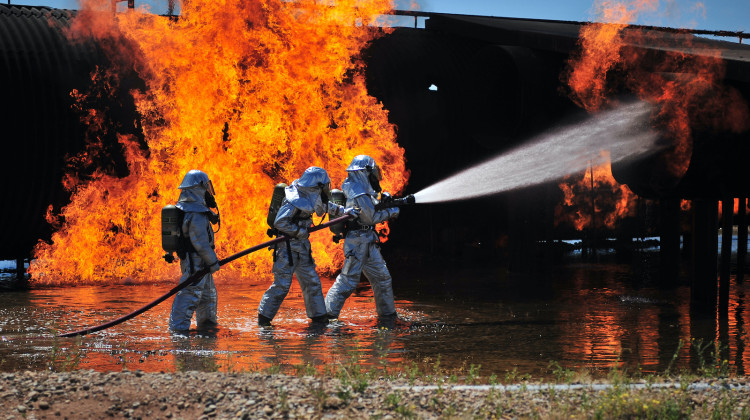
Firefighting foams with PFAS are used to contain highly flammable fires like this that can't be extinguished with water. (Eboni Reece / U.S. Department of Defense)
rawpixel.com / U.S. Department of Defense (Source)/rawpixel.com / U.S. Department of Defense (Source)A state program meant to protect firefighters from harmful PFAS in firefighting foam is ending. Indiana will no longer collect and dispose of the foam after Dec. 30. That’s when the state’s contract with the disposal company runs out.
Exposure to PFAS has been linked to problems with the immune system, developmental issues in children and cancer — the leading cause of death among firefighters.
David Hosick is the director of public affairs for the Indiana Department of Homeland Security — which oversees the collection program along with the state Department of Environmental Management.
“It's a significant issue, one that's talked about more than it's ever been. And the EPA efforts nationally related to PFAS materials supports the idea that there are other alternatives out there," he said.
Firefighting foam with PFAS has also contaminated drinking water around military bases like Grissom Air Reserve near Kokomo.
These foams are commonly used for Class B fires which involve highly flammable or combustible liquids — like gasoline or grease — that can’t be put out with water.
Join the conversation and sign up for the Indiana Two-Way. Text "Indiana" to 765-275-1120. Your comments and questions in response to our weekly text help us find the answers you need on climate solutions and climate change at ipbs.org/climatequestions.
Hosick said it’s not clear which Indiana fire departments are still using foam with PFAS.
“We want to make sure that we're doing the best we can as a state to make sure that this stuff is not available to our firefighters and potentially our groundwater sources. So if there's a possibility to continue the program in some form or fashion moving forward, I think we'd all be interested in pursuing that," he said.
For now, there’s just not enough money to go around. IDHS encourages fire departments to sign up for the program by Dec. 1.
PFAS aren't just in firefighting foam — they're in many non-stick and stain-resistant products. Everything from cooking pans, to carpets to fast food wrappers.
The EPA has taken steps to limit certain PFAS in the environment, but there are thousands of individual PFAS chemicals — many of which industry is still allowed to use today.
Rebecca is our energy and environment reporter. Contact her at rthiele@iu.edu or follow her on Twitter at @beckythiele.
 DONATE
DONATE







 Support WFYI. We can't do it without you.
Support WFYI. We can't do it without you.